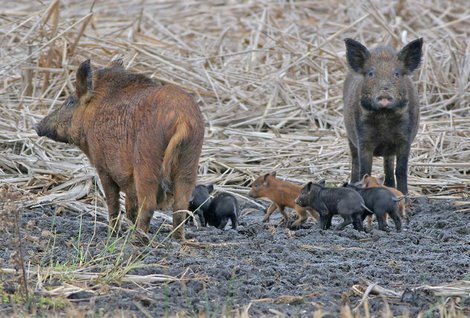A North Carolina State University study shows that, for the first time since testing began several years ago, feral pigs in North Carolina have tested positive for Brucella suis, an important and harmful bacteria that can be transmitted to people.
The bacteria are transmitted to humans by unsafe butchering and consumption of undercooked meat. Clinical signs of brucellosis, the disease caused by the bacteria, in people are fairly non-specific and include persistent flu-like symptoms. The bacteria can also spread in pig populations, causing abortions in affected swine.
In a study conducted to test N.C. feral pig populations for several types of bacteria and viruses, about 9 percent of feral pigs studied in Johnston County and less than 1 percent of feral pigs surveyed randomly at 13 other sites across the state showed exposure to B. suis.
Dr. Chris DePerno, associate professor of forestry and environmental resources at NC State and the corresponding author of a paper describing the research, says the results are troubling for people who hunt feral pigs for sport or food.
“Now that exposure to Brucella suis has been found in North Carolina’s feral pig populations, people need to take care when hunting, butchering and cooking feral pigs,” DePerno says. “That means wearing gloves when field dressing feral pigs and cooking the meat to the proper temperature.”
Dr. Suzanne Kennedy-Stoskopf, an NC State research professor of wildlife infectious diseases and a co-author of the paper, says that testing positive for antibodies to B. suis means the feral pigs have been exposed to and mounted an immune response against the bacteria. Antibodies do not eliminate B. suis from pigs, so the animals are considered infected and capable of transmitting the bacteria to other pigs and people. She adds that control and eradication programs introduced in the late 1990s eliminated swine brucellosis from all commercial pig populations in the United States.
Kennedy-Stoskopf says that B.suis can be transmitted among pig populations when pigs ingest infected tissue or fluids. Direct contact with infected pigs or ingestion of contaminated food and water could cause currently uninfected pig populations to become infected.
“Spillover from infected feral pigs to commercial pigs is an economic and a public-health concern,” Kennedy-Stoskopf says. “The biggest public-health risk is to pork processors and hunters who field dress feral pigs. Although cases of brucellosis are rare in the United States, people need to understand the clinical signs – like intermittent fevers and persistent headaches – and go to the doctor for diagnosis and treatment if they have these flu-like symptoms.” Because clinical signs are so non-specific, it is important to tell your physician if you have had any exposure to feral swine carcasses and meat.
Feral pig populations are exploding across the country, DePerno says. Besides the rabbit-like reproductive proclivity of feral pigs, people are partially responsible for the population boom. There is strong evidence that humans have transported feral pigs into new areas for hunting.
“Control of feral pig populations is difficult at best,” DePerno says. “Research indicates that about 70 percent of the population will need to be removed each year to keep a wild population stable. Regarding feral pigs, hunting usually removes from 8 to 50 percent of a given wild population.”
Feral pigs can be destructive to the environment and can outcompete native animals. They dig, root and tear up crop lands; eat just about anything; and can spread disease to animals and people.
DePerno hopes that more research on how far feral pigs travel – and increased scrutiny of hunters who move feral pigs from place to place – will help keep feral populations from spreading.
NC State graduate student Mark Sandfoss and postdoctoral researcher Dr. Maria Palamar conducted research and co-authored the paper, which is published in the Journal of Wildlife Diseases. Researchers from the U.S. Department of Agriculture and Rollins Animal Disease Diagnostic Laboratory contributed to the research.
The study was funded by NC State’s Fisheries, Wildlife and Conservation Biology Program and the Department of Forestry and Environmental Resources; the Howell Woods Environmental Learning Center; and the U.S. Department of Agriculture/APHIS/Wildlife Services National Wildlife Disease Program.


